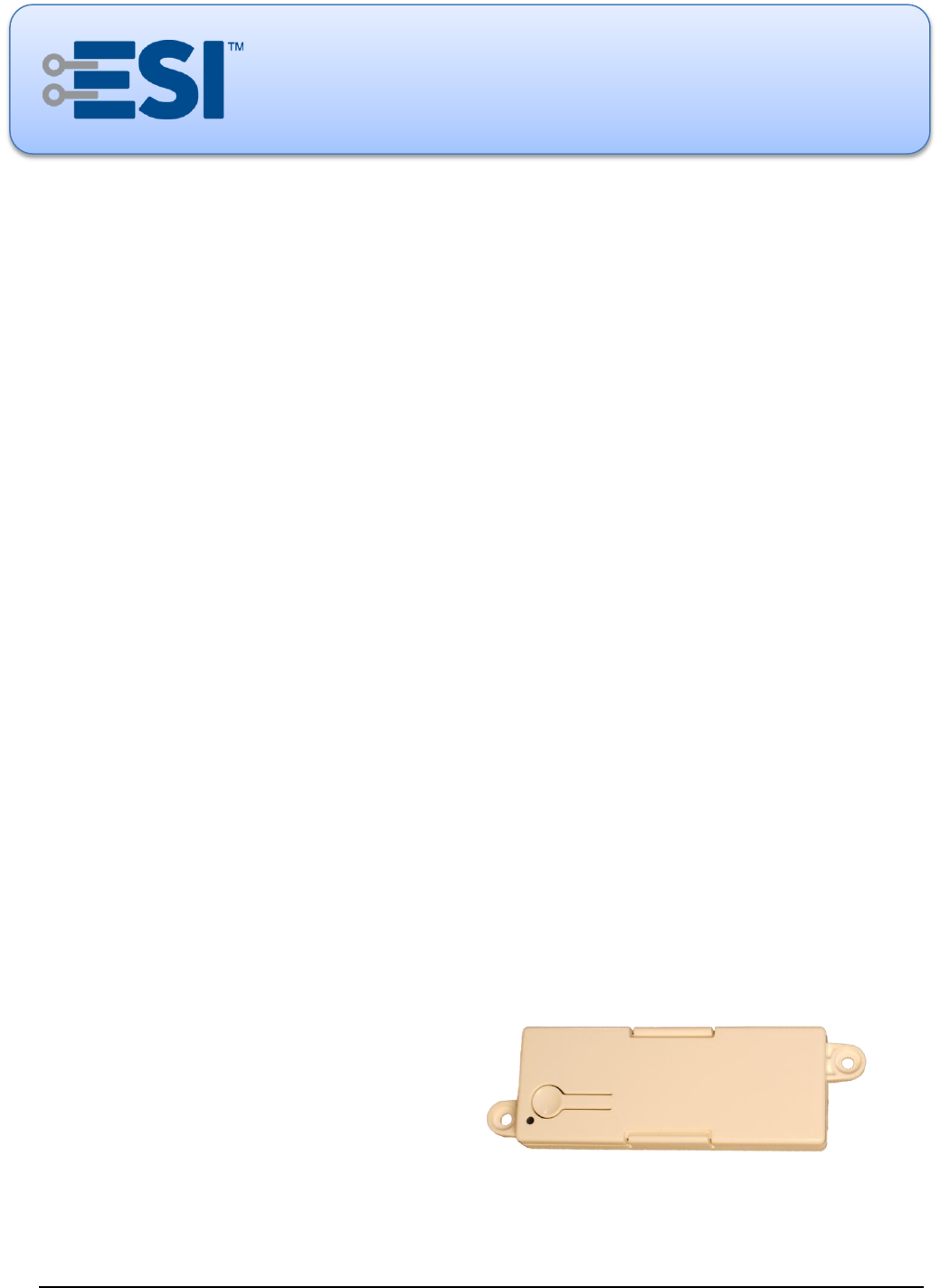Electronic Solutions RFRQTRANS Remote Control User Manual manual
Electronic Solutions, Inc. Remote Control manual
manual

August 2012, rev 1 © 2012 Electronic Solutions, Inc. Page 1 of 2
ESI RF RQ Transceiver
Install Guide - DRAFT
Electronic Solutions, Inc.
1355 Horizon Avenue
Lafayette, CO 80026 U.S.A.
www.elec-solutions.com
Tel: (303) 469-9322
Introduction
The ESI RF RQ Transceiver allows RQ devices to be added to ESI RF networks. The ESI RF RQ Transceiver
connects to the QEYE modular jack of AUM, DUM, EOS V2 and Forest Drapery track (TCS) RQ devices
without adding an additional power supply. When the ESI RF RQ Transceiver is networked with a V2 SUITE
remote, the attached RQ device will work in the following modes just like an ESI RF v2 motor:
Latch and Run fashion, the same as the initial production release of SUITE remote (v1).
Tilt Mode, replicating as much as possible the Tilt modes implemented in the RF Switch Interface.
These two methods of operation will be implemented as separate sub-modes of operation of the remote while
in User mode.
The ESI RF RQ Transceiver is considered a V2 ESI RF device, meaning it can respond appropriately to
SUITE V2 tilt commands and it can assign unique network groups to a SUITE V2 remote.
NOTE: a SUITE v2 remote cannot be used to set upper and lower limits for RQ devices connected to an ESI
RF RQ Transceiver. The upper and lower limits of all RQ devices must be set prior to connecting the ESI RF
RQ Transceiver. The RQ devices must also be calibrated before connecting the ESI RF RQ Transceiver --
ONLY if you want to set a PRESET.
COMMANDS
Join a Network: Plug into QEYE port, goes into Network Search (NOTE: only if at factory default with
no network information).
Triple button press: A “reset” to defaults. Clears network information and enters into Network Search
Mode.
Single button press: “Identifies” the dongle (for the Link Mode functions used on a remote).
Installation Steps
1. Set up and configure (limits and scenes) an ESI RF network of motor(s) and SUITE remote(s).
2. Join the ESI RF RQ Transceiver to the ESI RF network — plug into QEYE port on RQ device.
3. Test shade movement using buttons on the SUITE remote.
Parts List
Included:
ESI RF RQ Transceiver.
ESI RF Antenna (2.4 GHz) - onboard.
Usage:
Interior use only.
Top view

ESI RF RQ Transceiver Installation Guide
www.elec-solutions.com © 2012 Electronic Solutions, Inc. Page 2 of 2
SPECIFICATIONS
Overall Dimensions: Length: 4.54 in. Width: 1.40 in. Thickness: 0.50 in.
Electrical
Communicates with ESI RF devices, version 1, and later.
Power: external, 5V supplied by RQ device
Frequency: 2.4 GHz
Regulatory Compliance
This device complies with part 15 of the FCC Rules. Operation is subject to the following two conditions: (1) This
device may not cause harmful interference, and (2) this device must accept any interference received, including
interference that may cause undesired operation.
Le présent appareil est conforme aux CNR d'Industrie Canada applicables aux appareils radio exempts de licence.
L'exploitation est autorisée aux deux conditions suivantes : (1) l'appareil ne doit pas produire de brouillage, et (2)
l'utilisateur de l'appareil doit accepter tout brouillage radioélectrique subi, même si le brouillage est susceptible d'en
compromettre le fonctionnement.
This Class B digital apparatus complies with Canadian ICES-003.
This equipment has been tested and found to comply with the limits for a Class B digital device, pursuant to part 15 of
the FCC Rules. These limits are designed to provide reasonable protection against harmful interference in a
residential installation. This equipment generates, uses and can radiate radio frequency energy and, if not installed
and used in accordance with the instructions, may cause harmful interference to radio communications. However,
there is no guarantee that interference will not occur in a particular installation. If this equipment does cause harmful
interference to radio or television reception, which can be determined by turning the equipment off and on, the user is
encouraged to try to correct the interference by one or more of the following measures:
—Reorient or relocate the receiving antenna.
—Increase the separation between the equipment and receiver.
—Connect the equipment into an outlet on a circuit different from that to which the receiver is connected.
—Consult the dealer or an experienced radio/TV technician for help.
Changes or modifications not expressly approved by the party responsible for compliance could void the user's
authority to operate the equipment.
FCC ID: P7RRFRQTRANS
IC: 7206A-RFRQTRANS
Disclaimer
Information in this document is subject to change without notice. The manufacturer does not make any
representations or warranties (implied or otherwise) regarding the accuracy and completeness of this document and
shall in no event be liable for any loss of profit or any commercial damage, including but not limited to special,
incidental, consequential, or other damage.